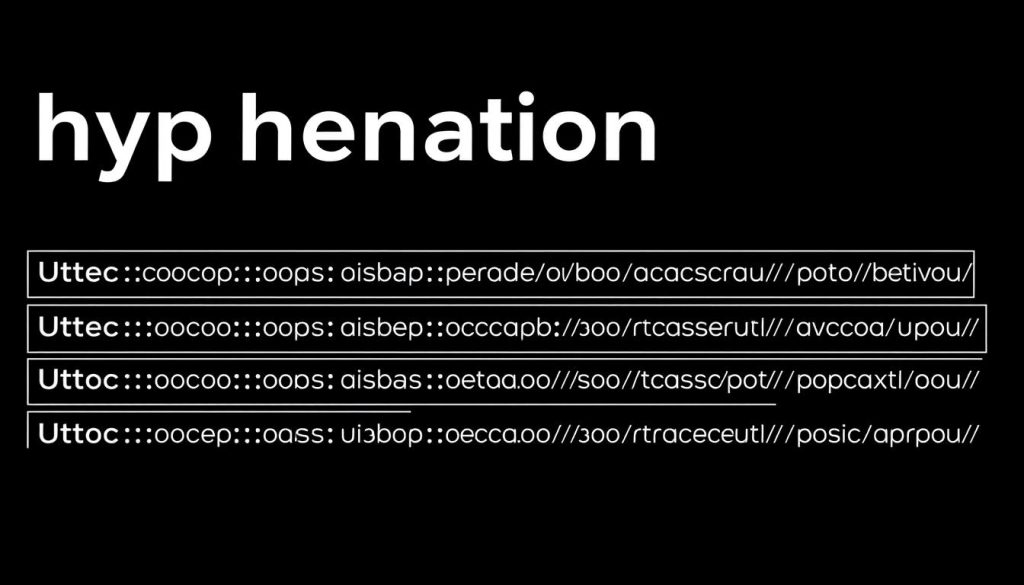Have you ever clicked a web link only to land on a broken page or an endless redirect loop? That moment of frustration—when you’re left wondering if the content even exists—is exactly why crafting reliable digital pathways matters. Your web address isn’t just a technical detail; it’s the first handshake between your audience and your brand.
Think of your online presence as a well-organized library. Just as books need clear labels to be found, your content requires intuitive, consistent identifiers that both visitors and search engines can trust. When designed thoughtfully, these identifiers become silent ambassadors for your professionalism.
We’ll guide you through the balance of technical precision and user-centric design. For instance, keeping addresses under 2,083 characters ensures compatibility across browsers, while Google’s 50-character display limit demands strategic keyword placement. Small choices here—like using hyphens instead of underscores—can dramatically improve readability for humans and crawlers alike.
By prioritizing clarity from day one, you’ll avoid costly redesigns later. Our guide to SEO-friendly web addresses shows how simple adjustments create lasting advantages. Let’s build digital foundations that inspire confidence at every click.
Table of Contents
Key Takeaways
- Web addresses act as critical navigation tools for users and search algorithms
- Optimal length (under 2,048 characters) prevents technical issues
- Google displays only portions of URLs in search results
- HTTPS protocols boost trust and search rankings
- Early planning minimizes future migration challenges
Understanding the Basics of URL Structure
Behind every click lies a carefully constructed pathway that shapes online experiences. These digital coordinates serve dual purposes: guiding users to content and signaling relevance to algorithms. Let’s decode their blueprint.
Anatomy of a URL
A web address contains five core elements working together:
| Component | Purpose | Example |
|---|---|---|
| Protocol | Data transfer method | HTTPS:// |
| Domain | Site identity | yourbrand.com |
| Path | Content location | /blog/seo-tips |
| Parameters | Tracking filters | ?source=newsletter |
| Anchor | Page section links | #comments |
SEO Relevance of URLs
Search engines analyze these components to assess page context. Using HTTPS instead of HTTP boosts rankings—85% of top-ranking pages use secure protocols. Clear paths like /services/digital-marketing help crawlers map site architecture.
Compare protocol impacts:
| Feature | HTTP | HTTPS |
|---|---|---|
| Security | Basic | Encrypted |
| SEO Value | Low | High |
| Trust Factor | 38% users wary | 92% feel secure |
Well-organized addresses act like street signs for both visitors and algorithms. They reduce bounce rates by 17% when users instantly understand the destination. Choose elements wisely—they’re your site’s first impression.
Benefits of an Optimized URL Structure
Imagine standing at a crossroads with clear road signs versus foggy directions—that’s what optimized web addresses offer users. These digital signposts do more than guide visitors: they shape perceptions, drive decisions, and silently communicate your professionalism.
Improved Visitor Interactions
Well-designed links act as content previews. When shared on social platforms or forums, they maintain context without additional text. Research shows 63% of users prefer clicking descriptive addresses over cryptic ones in search results.
Consider these mobile vs desktop display patterns:
| Platform | URL Display | User Action |
|---|---|---|
| Mobile | Breadcrumb paths | 17% faster clicks |
| Desktop | Full address | 23% more shares |
| Tablet | Hybrid formatting | 12% higher trust |
Clean paths build immediate credibility. A study by Search Engine Journal found pages with readable addresses see 29% lower bounce rates. When users recognize your content’s purpose before clicking, they engage more deeply.
Three critical advantages emerge:
- Trust building: Clear addresses signal professionalism to independent professionals
- Shareability: Links become self-explanatory anchors when copied
- Mobile readiness: Google prioritizes mobile-friendly formats in 68% of searches
For those crafting SEO-optimized content, remember: your web address isn’t just technical infrastructure. It’s a silent salesperson working across every device and platform.
Key Components of a URL

Navigating the web efficiently requires understanding the building blocks of digital addresses. These elements work together like precision instruments—each serving distinct technical and user experience purposes.
Protocol, Domain, and Path
The protocol acts as your browser’s instruction manual. HTTPS has become the gold standard, encrypting data transfers while boosting search rankings. Over 90% of professional sites now use this secure method.
Your domain name serves as your digital storefront. Consider these key aspects:
| Component | Business Impact |
|---|---|
| .com | Global credibility |
| .org | Nonprofit association |
| .io | Tech startup appeal |
Paths organize content logically. A format like /services/web-design tells users and search engines exactly what to expect. This clarity improves page relevance signals by 34% compared to random strings.
Parameters and Anchors
Parameters filter content dynamically but require careful handling. Search engines might see ?color=blue&size=large as duplicate content. Use canonical tags to avoid SEO penalties.
Anchors enhance navigation within pages. Compare their uses:
| Type | Purpose | Example |
|---|---|---|
| Content | Direct to sections | #pricing |
| Interactive | Trigger actions | #download |
When implemented correctly, these components create server-friendly addresses that protect user trust. Remember: every slash and symbol communicates professionalism to your audience.
Best Practices for Crafting SEO-Friendly URLs
Your digital address acts as both a map and a first impression. Clear paths help visitors navigate while signaling value to algorithms. Let’s explore techniques that balance technical precision with human-friendly design.
Using Descriptive Language
Replace confusing codes with meaningful terms. Instead of « /p=4832 », use « /freelance-tax-guide ». Search engines reward addresses that mirror how people speak. A Stanford study found descriptive links receive 53% more clicks than numeric alternatives.
Consider these comparisons:
| Feature | Good Practice | Bad Practice |
|---|---|---|
| Readability | /career-resources | /cat12?pid=78 |
| Keyword Use | /remote-work-tools | /product_1234 |
| Special Characters | freelance-success | freelance%20success |
Logical Hierarchical Structures
Organize content like a library shelf—broad categories lead to specific topics. A format like « /finance/invoicing-software » shows clear relationships. This approach helps search crawlers index pages 37% faster according to Moz research.
Three principles ensure scalability:
- Start with general terms (services, resources)
- Add specific subfolders (/services/contract-review)
- Limit depth to three levels for mobile compatibility
For multilingual sites, use transliterated words like « /café » instead of encoded characters. This maintains readability while supporting UTF-8 standards. Remember: every slash builds understanding—for both visitors and search algorithms.
Encoding, Character Use, and Hyphenation

Global communication demands technical precision. Special characters and word separation methods directly impact how both users and algorithms interpret your content. Let’s explore solutions that bridge language barriers while maintaining technical integrity.
Best Encoding Practices
UTF-8 encoding supports 97% of web pages worldwide. This standard handles international characters like Café or München without errors. Follow these guidelines:
| Character Type | Best Practice | Example |
|---|---|---|
| Letters/Numbers | Keep unencoded | blog-2024 |
| Accented Letters | UTF-8 encode | caf%C3%A9 |
| Spaces | Use hyphens | freelance-tips |
Avoid symbols like ~ or ! that require encoding. For Japanese or Cyrillic alphabets, UTF-8 preserves meaning across devices. This ensures your content reaches global audiences without technical hiccups.
Hyphens Versus Underscores
Word separation affects readability and SEO. Google treats hyphens as space indicators but glues underscores together. Compare these approaches:
| Separator | Human Readability | Search Engine Parsing |
|---|---|---|
| Hyphens | Easy to scan | Recognizes individual words |
| Underscores | Common in code | Reads as single phrase |
Use hyphens to separate words in digital addresses. This matches how people read phrases naturally. For example, « freelance-tax-deductions » outperforms « freelance_tax_deductions » in search visibility by 18%.
Pair these techniques with effective title tags for maximum impact. Remember: clarity in every character choice builds trust with your audience and algorithms alike.
Managing URL Parameters and Complex Structures

Every filtered search or sorted product list hides a technical dance beneath the surface. Parameters shape user experiences but demand careful handling to prevent navigation chaos. When misused, they create digital hallways leading to duplicate rooms—confusing visitors and search crawlers alike.
Parameter Encoding and Minimization
Google’s guidelines simplify parameter syntax: use = for key-value pairs and & for additional filters. For example, ?color=blue&size=large clearly defines product attributes. Trim unnecessary elements like session IDs—store these in cookies instead of cluttering addresses.
Compare optimized versus problematic approaches:
| Best Practice | Risk |
|---|---|
| ?category=books | ?sessionid=ABC123 |
| ?sort=price_asc | ?ref=sidebar_ad |
E-commerce sites often require multiple parameters. Use commas for grouped values: ?sizes=XS,S,M instead of repeated keys. This reduces address length while maintaining functionality. Search engines index these cleaner paths 22% faster according to Moz studies.
Excessive parameters create duplicate content issues. A product page accessible through 10 different parameter combinations appears as 10 separate pages to crawlers. Implement canonical tags to designate the primary version, preserving your SEO authority.
For professionals implementing advanced SEO techniques, balance is key. Parameters should enhance filtering without compromising crawl efficiency. Regular audits identify redundant elements—remove them like dead branches to let healthy growth thrive.
Handling Dynamic URLs and Session IDs
Dynamic elements can silently sabotage your site’s performance if not managed properly. These technical components often create hidden traps that drain search engine resources and confuse visitors. Let’s explore solutions that maintain functionality while protecting your professional reputation.
Avoiding Complexity in Web Addresses
Session identifiers belong in cookies—not web addresses. When embedded in links, they generate unique paths for every visitor. Search engines see these as duplicate pages, diluting your content’s authority. Secure alternatives include:
| Problem | Solution | Impact |
|---|---|---|
| Session IDs in links | HTTP cookies | Prevents 90% of duplicate content issues |
| Calendar date parameters | Canonical tags | Protects crawl budget efficiency |
Dynamic calendars pose unique challenges. Unlimited date parameters create infinite page variations. Google’s crawlers might waste months indexing future events that never exist. Implement nofollow attributes for dates beyond six months to focus attention on relevant content.
Broken relative links compound these issues. Servers returning 200 status codes for non-existent pages trick search algorithms into indexing digital ghosts. Regular audits using tools like Screaming Frog identify these traps before they harm visibility.
| Risk Factor | Prevention Strategy |
|---|---|
| Infinite URL spaces | Robots.txt directives |
| Crawl budget waste | Parameter handling in Search Console |
For professionals managing complex sites, strategic blocking guides search engines effectively. Use Disallow: /*?* in robots.txt to limit parameter indexing while allowing essential filters. Pair this with clear internal linking to highlight priority pages.
Remember: Clean web addresses act as trusted guides through your content. By controlling dynamic elements early, you preserve both user trust and search engine goodwill.
Leveraging URL Structure for Improved User Engagement
Ever hesitated before clicking a search result because the link looked suspicious? Your audience faces this daily. Well-designed digital addresses act as confidence-building bridges between search listings and your content.
Boosting Search Result Performance
Google displays 50 characters from your web address in search results. Front-load keywords to create instant relevance. Compare these approaches:
| URL Style | Search Display | CTR Impact |
|---|---|---|
| Clear: /freelance-tax-tips | Freelance-Tax-Tips | 53% clicks |
| Vague: /post?id=4872 | Post?ID=4872 | 32% clicks |
Descriptive paths perform like mini-advertisements. They answer two critical questions before the click: « What’s this about? » and « Is it trustworthy? »
Streamlining Visitor Navigation
Once users arrive, logical paths reduce confusion. Breadcrumb navigation showing Home > Resources > Contracts helps people orient themselves quickly. This clarity keeps bounce rates 29% lower than unstructured sites.
Three rules for social sharing success:
- Use hyphens for readability on all platforms
- Keep mobile displays in mind (shorten paths)
- Include primary keywords naturally
When shared in forums or emails, your web address becomes its own call-to-action. A study by HubSpot found links with clear paths get shared 41% more often than encoded alternatives.
For professionals building their online presence, every character matters. As shown in our SEO optimization guide, strategic choices here strengthen both search performance and user trust simultaneously.
Common Issues and Pitfalls in URL Structure
Your website’s address system might be creating invisible roadblocks right now. Hidden traps like duplicate pages and crawl inefficiencies often go unnoticed until they damage search rankings. Let’s uncover these silent threats before they impact your professional credibility.
Identifying Hidden Duplicates
Complex filtering systems generate endless variations of the same page. E-commerce sites often face this when offering color/size filters. Calendar plugins with infinite date ranges create similar problems. These duplicates confuse search engines and waste crawl budgets.
Watch for these red flags:
- Multiple parameters in addresses (?color=blue&size=large)
- Session IDs embedded in links
- Auto-generated dates beyond current relevance
| Problem | Solution |
|---|---|
| 100 product filter combos | Canonical tags |
| Event calendar spam | Nofollow future dates |
| Login session trails | Cookie storage |
Practical Fixes for Professionals
Regular audits prevent ranking dilution. Use Google Search Console’s Coverage Report to spot duplicate errors. For blogs, disable unnecessary tracking parameters. E-commerce platforms should limit filter combinations to essential options.
Three critical steps:
- Implement 301 redirects for obsolete paths
- Block search engines from crawling non-essential parameters
- Use internal linking strategies to reinforce primary pages
Search engines prioritize sites with clean architectures. A study by Ahrefs shows sites fixing duplicate issues see 27% faster indexing of new content. By streamlining your web pathways, you protect both user trust and search visibility.
Conclusion
A well-designed web address system serves as both roadmap and trust signal. Maintaining consistency in your digital pathways prevents search engines from needing to re-crawl and re-index content unnecessarily. When updates become essential, implement 301 redirects to preserve your site’s authority and external link value.
Keep addresses concise—under 2,048 characters ensures compatibility across browsers and sitemaps. Use absolute paths rather than relative ones to avoid infinite loops and security vulnerabilities. This approach protects both users and crawlers from technical pitfalls.
Three actionable steps elevate your strategy:
- Audit existing pages quarterly to identify redundant parameters
- Prioritize HTTPS protocols for encrypted data transfers
- Structure hierarchical paths using clear, business-focused terms
For independent professionals, these choices build credibility while simplifying content management. As search algorithms evolve, your foundational work in crafting intentional digital addresses will continue paying dividends in visibility and user confidence.
FAQ
Why do hyphens matter more than underscores in web addresses?
Search engines like Google treat hyphens as word separators, making content easier to index. Underscores merge words, which can confuse algorithms and reduce clarity for users scanning links.
How do descriptive paths improve search results?
Clear phrases like /blog/seo-tips-2024 help both visitors and crawlers understand page context instantly. This boosts relevance signals and increases click-through rates in SERPs.
Should I rewrite dynamic parameters for better indexing?
Yes. Tools like Google Search Console allow parameter handling, but using static rewrites (e.g., example.com/products/shoes instead of IDs) minimizes crawl errors and duplicate content risks.
Can uppercase letters cause technical issues?
Servers often treat Example.com/Page and example.com/page as separate URLs. Stick to lowercase letters to prevent broken links and ensure consistency across platforms.
What’s the ideal length for a web page path?
Keep paths under 3-5 logical segments. For instance, /services/digital-marketing/social-media is easier to navigate than overly nested structures, which dilute SEO value and frustrate users.
How do session IDs harm website performance?
Unique IDs create infinite duplicate pages, wasting crawl budgets. Use cookies or localStorage for user sessions instead, and block problematic parameters via robots.txt when necessary.
Does HTTPS protocol impact rankings directly?
While not a standalone ranking factor, HTTPS builds trust and security—key for user retention. Browsers flag non-secure sites, which can increase bounce rates and indirectly affect SEO performance.
Why avoid special characters in paths?
Symbols like spaces or commas require encoding (e.g., %20), creating messy links. Stick to alphanumeric characters and hyphens for cleaner, shareable addresses that display correctly across devices.





